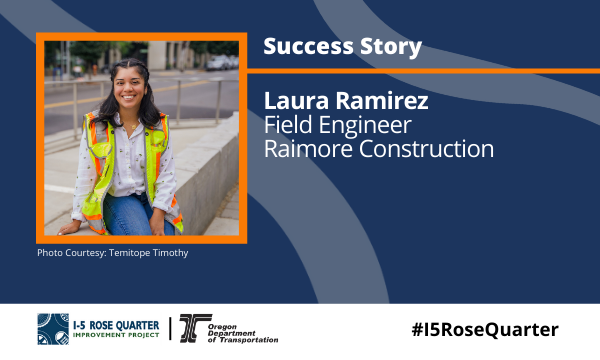Meet the Changemakers: Laura Ramirez and Crystal Stone
The remainder of the year, we’ll be introducing members of the Raimore Construction team − the folks gearing up to build the I-5 Rose Quarter Improvement Project. Watch for new releases every other Wednesday on our Success Stories page or through ODOT’s Urban Mobility Office Twitter page.
 “Growing up, if I didn't see girls doing something, then I would want to do that thing.”
Women in construction make up just 1.5 percent of the nation’s workforce − a daunting statistic that hints at the challenges women face in the field. Laura Ramirez, a field engineer at Raimore Construction, is trying to change that statistic and prove that women like her can pivot their careers into these in-demand, rewarding jobs.
Laura’s career path didn’t initially start with construction, but from a young age, she was set on economic mobility. During the 1980s, her mother escaped the civil unrest happening in El Salvador and immigrated to Portland, building a life for herself and Laura by working long hours cleaning houses.
 “Working in an industry dominated by white men, Black women have to work twice as hard to get the same outcome as our peers.”
When a fire destroyed their home in Galveston, Texas almost 90 years ago, Crystal Stone’s great-grandparents moved west, first to Vancouver before buying a home in Northeast Portland. Her great-grandfather quickly became a central pillar in the community, helping to establish the New Hope Missionary Baptist Church. Homeownership and entrepreneurialism ran deep in her family, and Northeast Portland proved to be fertile ground for their efforts: her grandparents on one side of the family owned a home on Northeast Rodney and Going, and her grandfather had a barbershop on Northeast 7th and Knott. Her maternal grandmother still lives in the area.
The family has witnessed vast changes in Northeast Portland. The church co-founded by her great-grandfather was displaced during the redevelopment period in the 1950s and 1960s that brought I-5 and Legacy Emanuel Hospital to Albina − a devastating experience for the congregants and the larger community. Even now, Portland’s neighborhoods continue to change, altering the cultural fabric in significant ways. “To see how much the city has changed in the last 15 years is kind of scary,” she says.
|